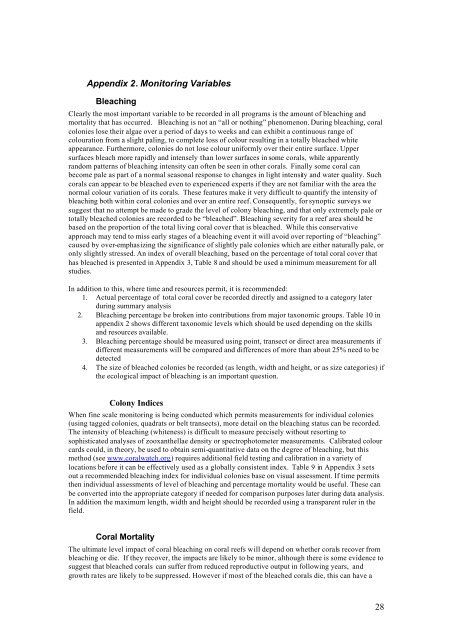Oliver et al (2004) Monitoring bleaching
Oliver et al (2004) Monitoring bleaching.pdf
Oliver et al (2004) Monitoring bleaching.pdf
Create successful ePaper yourself
Turn your PDF publications into a flip-book with our unique Google optimized e-Paper software.
Appendix 2. <strong>Monitoring</strong> Variables<br />
Bleaching<br />
Clearly the most important variable to be recorded in <strong>al</strong>l programs is the amount of <strong>bleaching</strong> and<br />
mort<strong>al</strong>ity that has occurred. Bleaching is not an “<strong>al</strong>l or nothing” phenomenon. During <strong>bleaching</strong>, cor<strong>al</strong><br />
colonies lose their <strong>al</strong>gae over a period of days to weeks and can exhibit a continuous range of<br />
colouration from a slight p<strong>al</strong>ing, to compl<strong>et</strong>e loss of colour resulting in a tot<strong>al</strong>ly bleached white<br />
appearance. Furthermore, colonies do not lose colour uniformly over their entire surface. Upper<br />
surfaces bleach more rapidly and intensely than lower surfaces in some cor<strong>al</strong>s, while apparently<br />
random patterns of <strong>bleaching</strong> intensity can often be seen in other cor<strong>al</strong>s. Fin<strong>al</strong>ly some cor<strong>al</strong> can<br />
become p<strong>al</strong>e as part of a norm<strong>al</strong> season<strong>al</strong> response to changes in light intensity and water qu<strong>al</strong>ity. Such<br />
cor<strong>al</strong>s can appear to be bleached even to experienced experts if they are not familiar with the area the<br />
norm<strong>al</strong> colour variation of its cor<strong>al</strong>s. These features make it very difficult to quantify the intensity of<br />
<strong>bleaching</strong> both within cor<strong>al</strong> colonies and over an entire reef. Consequently, for synoptic surveys we<br />
suggest that no attempt be made to grade the level of colony <strong>bleaching</strong>, and that only extremely p<strong>al</strong>e or<br />
tot<strong>al</strong>ly bleached colonies are recorded to be “bleached”. Bleaching severity for a reef area should be<br />
based on the proportion of the tot<strong>al</strong> living cor<strong>al</strong> cover that is bleached. While this conservative<br />
approach may tend to miss early stages of a <strong>bleaching</strong> event it will avoid over reporting of “<strong>bleaching</strong>”<br />
caused by over-emphasizing the significance of slightly p<strong>al</strong>e colonies which are either natur<strong>al</strong>ly p<strong>al</strong>e, or<br />
only slightly stressed. An index of over<strong>al</strong>l <strong>bleaching</strong>, based on the percentage of tot<strong>al</strong> cor<strong>al</strong> cover that<br />
has bleached is presented in Appendix 3, Table 8 and should be used a minimum measurement for <strong>al</strong>l<br />
studies.<br />
In addition to this, where time and resources permit, it is recommended:<br />
1. Actu<strong>al</strong> percentage of tot<strong>al</strong> cor<strong>al</strong> cover be recorded directly and assigned to a category later<br />
during summary an<strong>al</strong>ysis<br />
2. Bleaching percentage be broken into contributions from major taxonomic groups. Table 10 in<br />
appendix 2 shows different taxonomic levels which should be used depending on the skills<br />
and resources available.<br />
3. Bleaching percentage should be measured using point, transect or direct area measurements if<br />
different measurements will be compared and differences of more than about 25% need to be<br />
d<strong>et</strong>ected<br />
4. The size of bleached colonies be recorded (as length, width and height, or as size categories) if<br />
the ecologic<strong>al</strong> impact of <strong>bleaching</strong> is an important question.<br />
Colony Indices<br />
When fine sc<strong>al</strong>e monitoring is being conducted which permits measurements for individu<strong>al</strong> colonies<br />
(using tagged colonies, quadrats or belt transects), more d<strong>et</strong>ail on the <strong>bleaching</strong> status can be recorded.<br />
The intensity of <strong>bleaching</strong> (whiteness) is difficult to measure precisely without resorting to<br />
sophisticated an<strong>al</strong>yses of zooxanthellae density or spectrophotom<strong>et</strong>er measurements. C<strong>al</strong>ibrated colour<br />
cards could, in theory, be used to obtain semi-quantitative data on the degree of <strong>bleaching</strong>, but this<br />
m<strong>et</strong>hod (see www.cor<strong>al</strong>watch.org) requires addition<strong>al</strong> field testing and c<strong>al</strong>ibration in a vari<strong>et</strong>y of<br />
locations before it can be effectively used as a glob<strong>al</strong>ly consistent index. Table 9 in Appendix 3 s<strong>et</strong>s<br />
out a recommended <strong>bleaching</strong> index for individu<strong>al</strong> colonies base on visu<strong>al</strong> assessment. If time permits<br />
then individu<strong>al</strong> assessments of level of <strong>bleaching</strong> and percentage mort<strong>al</strong>ity would be useful. These can<br />
be converted into the appropriate category if needed for comparison purposes later during data an<strong>al</strong>ysis.<br />
In addition the maximum length, width and height should be recorded using a transparent ruler in the<br />
field.<br />
Cor<strong>al</strong> Mort<strong>al</strong>ity<br />
The ultimate level impact of cor<strong>al</strong> <strong>bleaching</strong> on cor<strong>al</strong> reefs will depend on wh<strong>et</strong>her cor<strong>al</strong>s recover from<br />
<strong>bleaching</strong> or die. If they recover, the impacts are likely to be minor, <strong>al</strong>though there is some evidence to<br />
suggest that bleached cor<strong>al</strong>s can suffer from reduced reproductive output in following years, and<br />
growth rates are likely to be suppressed. However if most of the bleached cor<strong>al</strong>s die, this can have a<br />
28


















